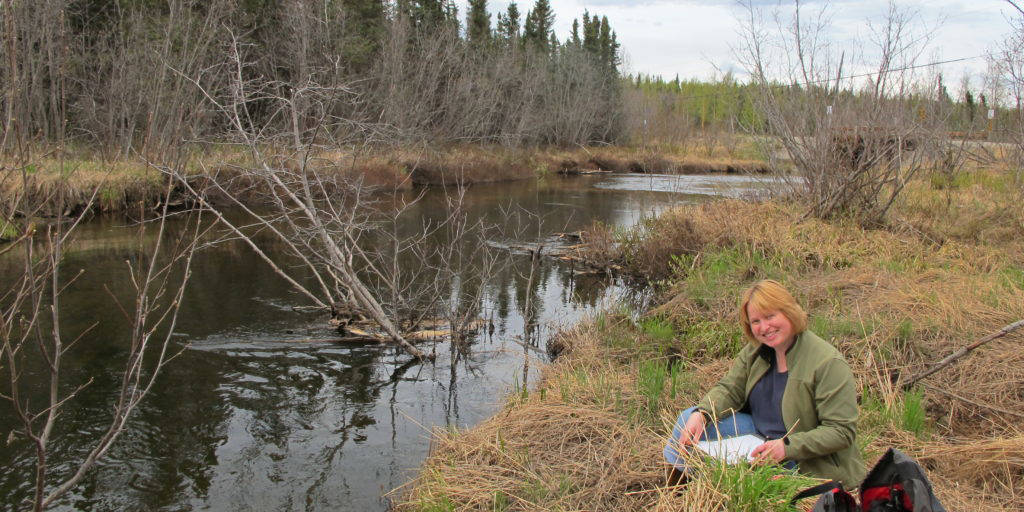Two years ago, Cook Inletkeeper Science Director Sue Mauger wrote a paper looking ahead at what Cook Inlet salmon streams might look like with climate change over the next 30 or 40 years, including the possibility that water temperatures might rise above 80 degrees Fahrenheit.
On July 7, during a “heat dome” of high air temperatures over Southcentral Alaska, a real-time stream temperature gauge in the Deshka River, a tributary of the Susitna River west of Wasilla, clocked a reading above 81.7 F.
“This is what we predicted, but it’s happening in 2019,” Mauger said in a phone interview while she dip netted for salmon in Kenai. “It’s disheartening to see, getting so high so fast.”
Cook Inletkeeper, the environmental watchdog nonprofit based in Homer, announced the finding last week in a press release. According to Mauger, it’s the first time in measuring selected Cook Inlet rivers and streams that any stream monitored has topped 80 degrees. Cook Inletkeeper did an earlier 5-year study of 48 nonglacial Cook Inlet streams, and from that study selected 16 streams that represent a variety of ecosystems in the Cook Inlet drainage. Cook Inletkeeper selected for real-time monitoring four of those streams, the Deshka River, Crooked Creek, the Anchor River and the Russian River.
The Anchor River also saw its highest temperatures records, hitting 73 degrees, but chinook continue to move upstream and met the lower escapement goal of 3,800 fish.
The Deshka has the highest chinook or king salmon escapement goal (13,000-28,000 spawning salmon) of upper Cook Inlet rivers and streams. It produces more than 20% of the chinook escapements for the Susitna River, according to the Inletkeeper press release.
“It’s a big important system,” Mauger said. “It’s amazing to see temperatures in the 80s.”
The real-time monitors are solar powered and has a Iridium satellite-text connection. Data is streamed hourly.
For spawning or juvenile salmons, plus-80 degree temperatures can be lethal. On the lower Kuskokwim River, residents reporting seeing dead pink salmon, victims of similar high temperatures. Mauger said the high temperatures affect salmon by making them lethargic because of lower oxygen concentrations in water. Cold water holds more oxygen and warm water holds less.
“Really cold water is 100% saturated with oxygen,” Mauger said. “As it warms up, it drops.”
Mauger compared salmon to Alaskans going to Hawaii in mid-winter.
“It sucks it out of you. You lose your appetite,” she said.
When salmon get lethargic, they also become susceptible to predation. The Deskha River has some pike, an invasive species more tolerant of heat.
“We may not see the dead juveniles,” Mauger said. “They’re getting scooped up. As they get more lethargic, the pike are enjoying them.”
Spawning salmon also need cold water and the high oxygen content so they can breathe better as they make the last push up the river to spawning beds. According to fish weir counts on the Deshka River, only 13 salmon had passed the weir in 13 days while water temperatures were hot. On July 13, when rain came and temperatures cooled off, 350 salmon moved through the weir.
“It’s likely there were a bunch of them holding low who moved through when things started to cool,” Mauger said.
Spawning salmon have a narrow window to make it upstream to spawn and then another window on the spawning grounds to lay or fertilize eggs. They need enough energy to tend their eggs before they die. When salmon hatch, they also stay in the river a year or two, and thus could be vulnerable should water temperatures rise.
Could river temperatures cooled off fast enough so that the Deshka chinooks spawned successfully?
“I don’t know,” Mauger said. “We won’t know until we see it expressed in the returns of that spawning group.”
Some scientists have speculated that declining chinook numbers could be caused by something going on in the oceans. Mauger and her coauthors have sent to peer review a paper looking at fresh water impacts on chinook populations. They looked at stream temperatures, flow date, fish runs based on weir counts, flood events, and other factors to see how that could be reflected in future returns.
“It’s one of the great joys of the salmon how complicated their life history is, but also one of the great frustrations trying to understand them,” Mauger said. “That is the joy of ecology: trying to understand all those connections, and being really excited when you can find a strong signal.”
Another factor Mauger has been studying is how salmon can find colder spots in rivers, either under cuts in river banks, under shady spots from trees and shrubs growing on the banks, or from groundwater entering rivers. Cook Inletkeeper has been working with private and other landowners to understand the importance of protecting land near streams to provide better habitat for salmon.
The Deshka River monitoring is funded through a cooperative agreement with the U.S. Fish and Wildlife Service and help from the Alaska Department of Fish and Game and the University of Alaska Anchorage Center for Conservation Science.


